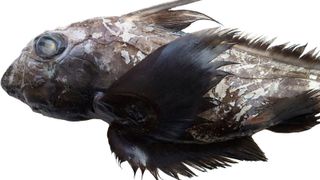
(Image credit: David A. Ebert)
While children are hunting for plastic eggs and others for salvation on Easter, scientists are searching the depths for new and undescribed sharks, called Rabbitfish, Ghost sharks or Chimaera. This month, scientists published a report of a new species of deepwater “ghost shark“ with a huge head one third its body length, and giant, iridescent eyes.
The dead immature male specimen was collected in 2018 during a bottom trawl in the Andaman Sea between 2,533 and 2543 feet (772 to 775 m) below the surface. The team of scientists led by Dr. David Ebert of the Pacific Shark Research Center at Moss Landing Marine Laboratories, described the discovery in a paper published March 6 in the journal Raffles Bulletin of Zoology. The species is named Chimaera supapae, after the late Supap Monkolprasit, a scientist from Thailand who spent her life studying cartilaginous fishes.
These elusive deep-sea fish, are a cartilaginous fish in the order Chimaeriformes distantly related to sharks. Chimaeras are among the oldest lineages of fishes going back 300-400 million years. Some species can grow up to 6.6 feet or 2m long. Chimaeras, including the relatively shallow California Spotted Rabbitfish (Hydrolagus colliei), live on continental slopes and ocean ridges of the deep sea. Many are found at depths below 1,640 feet (500 meters), with some described as deep as 8500 feet (2600 meters). These ghostly fish swim slowly in cold, lightless waters, feeding on benthic animals such as mollusks, crustaceans, and worms. Rarely captured alive, the specimens are described from deep sea trawls, and are frequently killed as bycatch in deep water fisheries.
According to Dr Ebert, previous to the discovery of Chimaera supapae there were only 53 known species of chimaera in the world. This makes 54!